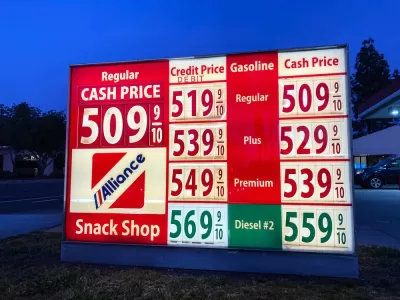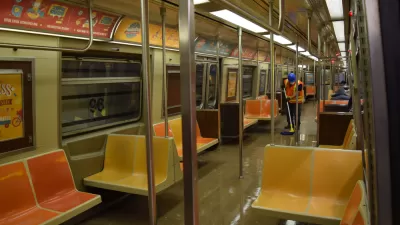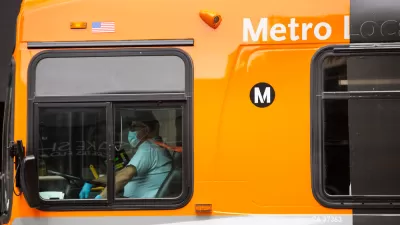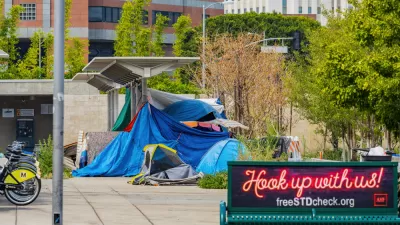The quick ascent of gas prices, at a time of economic uncertainty for many, could be just the boost public transit needs to get back to pre-pandemic levels of ridership. Or not.

High gas prices could contribute to a ridership rebound on U.S. public transit systems, according to an article by Savannah Maher for Marketplace, echoing what is surely a common speculation among transportation planners and alternative transportation advocates all over the country.
That possibility is debatable, however, as evidenced by past discussions:
- In 2004, rising gas prices failed to boost transit ridership, according to an article originally published by CBS News.
- In 2011, a study out of the University of Texas at El Paso showed a strong connection between transit ridership and gas prices: "Every 10 percent increase in fuel costs led to an increase in bus ridership of up to 4 percent, and a spike in rail travel of up to 8 percent."
- In 2015, gas prices were declining at the same time as transit ridership in the city of Los Angeles.
- In 2015, transit ridership stayed steady as gas prices declined in Chicago, according to an article by Adam Allington for Marketplace.
- In 2016, a study by the JP Morgan Chase Institute found a strong connection between gas prices and transit ridership: "For every dollar saved from lower gas prices at the pump, households decreased their spending on transit by some 14 cent."
The transportation mix is vastly different in 2022, with the negative effects of ride-hailing companies baked into transit ridership for years now. The pandemic has also inspired increasing numbers of people to ride bikes, thanks in part to the popularity of e-bikes. Recent changes in the American automobile market should also not be discounted in the mode choice equation. Electric cars are much more readily available than they were in the last gas price spike and recession, for example. But even more salient, perhaps, is the consumer trend toward larger and larger vehicles—instead of smaller, more efficient vehicles that would mitigate the effects of a spike in gas prices.
Some transit and bike advocates might see increasing transit and bike use as a silver lining of higher gas prices—the benefits to the environment and the potential for economic mobility as a result of more efficient transportation choices are well documented, but it's critical to remember that these changes are happening in the context of unprecedented wealth inequality (in which cars are both a barrier to, and a necessary enabler of, wealth accumulation), decreasing transit service, and, frankly, a brutal culture war that has co-opted almost all of the involved factors as ideological signifiers. And then there's the pandemic. The examples set by previous gas spike prices should not be considered a reliable predictor of current and future transportation trends in today's political and economic landscape.
Still, signs of increased transit use in recent weeks can be seen all over the country. "A few big-city transit systems, including Washington’s Metro and San Francisco’s BART, have seen slight increases in ridership since the beginning of March," according to Maher, from the article cited at the top of this article. Tri-Rail in South Florida also reports increasing ridership, according to an article by Ryan Hughes for WPTV.
Before rushing to connect recent ridership increases to gas prices, recall that recent ridership increases could also be the result of larger numbers of workers returning to the office.

Alabama: Trump Terminates Settlements for Black Communities Harmed By Raw Sewage
Trump deemed the landmark civil rights agreement “illegal DEI and environmental justice policy.”

Planetizen Federal Action Tracker
A weekly monitor of how Trump’s orders and actions are impacting planners and planning in America.

The 120 Year Old Tiny Home Villages That Sheltered San Francisco’s Earthquake Refugees
More than a century ago, San Francisco mobilized to house thousands of residents displaced by the 1906 earthquake. Could their strategy offer a model for the present?

Ken Jennings Launches Transit Web Series
The Jeopardy champ wants you to ride public transit.

BLM To Rescind Public Lands Rule
The change will downgrade conservation, once again putting federal land at risk for mining and other extractive uses.

Indy Neighborhood Group Builds Temporary Multi-Use Path
Community members, aided in part by funding from the city, repurposed a vehicle lane to create a protected bike and pedestrian path for the summer season.
Urban Design for Planners 1: Software Tools
This six-course series explores essential urban design concepts using open source software and equips planners with the tools they need to participate fully in the urban design process.
Planning for Universal Design
Learn the tools for implementing Universal Design in planning regulations.
Clanton & Associates, Inc.
Jessamine County Fiscal Court
Institute for Housing and Urban Development Studies (IHS)
City of Grandview
Harvard GSD Executive Education
Toledo-Lucas County Plan Commissions
Salt Lake City
NYU Wagner Graduate School of Public Service






























